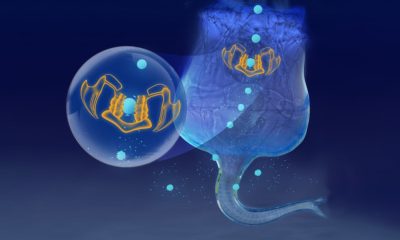Egg-laying mammal missing over 60 years photographed for first time in history
The long-beaked echidna was last recorded in 1961.
Published
6 months ago onBy
Talker News
By Pol Allingham via SWNS
A strange egg-laying mammal named after Sir David Attenborough has been rediscovered after going missing for 62 years.
The long-beaked echidna was last recorded in 1961 and has now been photographed for the first time in history.
And the expedition to the remote jungles of Indonesia's Papua Province also rediscovered a bird lost to science since 2008, Mayr's honeyeater and a shrimp that lives in trees.
The echidna has the spines of a hedgehog, the snout of an anteater, the feet of a mole and the nickname Attenborough, after the British nature broadcaster.
It was discovered on the last day using the last image from their last memory card.
The mammal is a monotreme, a species of egg-laying mammals including the platypus.
However, the “special” echidna is one of only five surviving monotreme species.

The Critically Endangered beasts are notoriously hard to find - they are nocturnal, live in burrows and are generally very shy.
To find the creature, members from several universities trekked across “one of the most unexplored regions in the world”, the Cyclops Mountains of Indonesia’s Papua Province.
During the “sometimes life-threatening’ journey through “extremely inhospitable” terrain, the scientists battled venomous animals, sucking leeches, malaria, earthquakes and exhausting heat, often cutting paths where no humans had ever been before.
They deployed over 80 trail cameras, ascended multiple mountains and climbed a total of over 11,000 meters - higher than Everest.
Local guides helped make the scientists makeshift labs in the heart of the jungle, with benches and desks made from forest branches and vines.
But after four weeks in the forest they had found nothing.
But on the final day, using the last images on the final memory card, the team captured the elusive mammal on camera.
The first-ever photographs of Attenborough’s echidna were verified by Professor Kristofer Helgen, mammalogist and chief scientist and director of the Australian Museum Research Institute.
Oxford University researchers joined forces with Indonesian NGO Yayasan Pelayanan Papua Nenda (YAPPENDA), Cenderawasih University (UNCEN), Papua BBKSDA, and the National Research and Innovation Agency of Indonesia (BRIN), Re:Wild.
Dr. James Kempton, a biologist from the University of Oxford who conceived of and led the expedition, said: “Attenborough's long-beaked echidna has the spines of a hedgehog, the snout of an anteater, and the feet of a mole.
“Because of its hybrid appearance, it shares its name with a creature of Greek mythology that is half human, half serpent.
“The reason it appears so unlike other mammals is because it is a member of the monotremes – an egg-laying group that separated from the rest of the mammal tree-of-life about 200 million years ago.
“The discovery is the result of a lot of hard work and over three and a half years of planning.
“‘A key reason why we succeeded is because, with the help of YAPPENDA, we have spent years building a relationship with the community of Yongsu Sapari, a village on the north coast of the Cyclops Mountains.
“The trust between us was the bedrock of our success because they shared with us the knowledge to navigate these treacherous mountains, and even allowed us to research on lands that have never before felt the tread of human feet.
“Though some might describe the Cyclops as a “Green Hell”, I think the landscape is magical, at once enchanting and dangerous, like something out of a Tolkien book.
“In this environment, the camaraderie between the expedition members was fantastic, with everyone helping to keep up morale.
"In the evening, we exchanged stories around the fire, all the while surrounded by the hoots and peeps of frogs.”
During the trip, the team also conducted the first comprehensive assessment of invertebrate, reptile, amphibian, and mammal life in the region in the Cyclops Mountains.
Combining scientific techniques with the Papuan team’s knowledge of the forest, the group discovered several dozens of insect species entirely new to science.
These included blind spiders, a blind harvestman, and a whip scorpion, all of which were found in a previously unexplored cave system on one of the sacred peaks above Yongsu Sapari, barely trodden land where the team was given special permission to research.

The caves were only discovered when one team member fell through a moss-covered entrance.
Dr. Leonidas-Romanos Davranoglou lead entomologist for the expedition, from Oxford University, said: “We were quite shocked to discover this shrimp in the heart of the forest, because it is a remarkable departure from the typical seaside habitat for these animals.
“We believe that the high level of rainfall in the Cyclops Mountains means the humidity is great enough for these creatures to live entirely on land.
“Tropical rainforests are among the most important and most threatened terrestrial ecosystems.
“It is our duty to support our colleagues on the frontline through exchanging knowledge, skills, and equipment.”
The conditions were extreme.
At one point, a sudden earthquake meant the team had to flee the cave system.
Dr. Davranoglou broke his arm in two places, a crewmate contracted malaria, and another had a leech attached to his eye for a day and a half before it was finally removed in the hospital.
Mosquitoes and ticks bit, they were constantly threatened by venomous snakes and spiders, and progressing through the jungle was slow and exhausting.
The expeditionists have only sorted a fraction of the material collected, and expect the coming months could yield even more new species – some of which will be named after the Papuan members of the journey.
Besides animal specimens, they brought home over 75 kg of rock samples, which could reveal how and when the Cyclops Mountains formed.
It is believed the range formed when an island arc in the Pacific Ocean collided with New Guinea's mainland around 10 million years ago.
They hope their study, published in Oxford University Press, will highlight the “extraordinary biodiversity” in the Cyclops Mountains, and the conservation needs of wider Indonesian New Guinea.
They are committed to monitoring the echidna long term.
Stories and infographics by ‘Talker Research’ are available to download & ready to use. Stories and videos by ‘Talker News’ are managed by SWNS. To license content for editorial or commercial use and to see the full scope of SWNS content, please email [email protected] or submit an inquiry via our contact form.
You may like


Sharkskin could be used to help humans heal wounds


Microscopic plankton rapidly escalating our planet’s plastic problem


Special toothpaste could save lives of people with peanut allergies


Research reveals breast cancer patients being forced out of jobs


Harvard study finds having flexible working hours good for your heart


Weed smokers ‘have more empathy’ than others
Other Stories


Blood test can detect signs of knee condition 8 years before X-rays
Early detection could lead to treatments that slow the progression of the most common form of arthritis.


Man captures ultra rare albino squirrel on camera
The white squirrel has red eyes so is thought to be an albino squirrel.


Adorable dog kicks his leg while he walks
A video captured the pup bouncing along the street of his native China.


Woman with rare ‘Sleeping Beauty’ condition sleeps every four hours
She was diagnosed at age 18 after years of struggling to stay awake in school and nodding off during class.


97-year-old veteran receives WWII service medal 80 years later
"We’re all so proud of Eve."
Top Talkers

 Animals2 days ago
Animals2 days agoAdorable dog kicks his leg while he walks

 Health6 days ago
Health6 days agoNew study reveals ‘old age’ begins later than it used to

 Wildlife5 days ago
Wildlife5 days agoClever elephant returns visitor’s shoe that fell into enclosure

 Lifestyle1 week ago
Lifestyle1 week agoWoman regrets her tattoo nightmare: ‘It’s horrendous’

 Good News6 days ago
Good News6 days agoDisabled student takes first steps in 10 years on graduation stage

 Entertainment3 days ago
Entertainment3 days agoWhat is the perfect movie length?

 Animals2 days ago
Animals2 days agoMan captures ultra rare albino squirrel on camera

 Broadcast2 days ago
Broadcast2 days agoAre allergies interfering with your social life?
